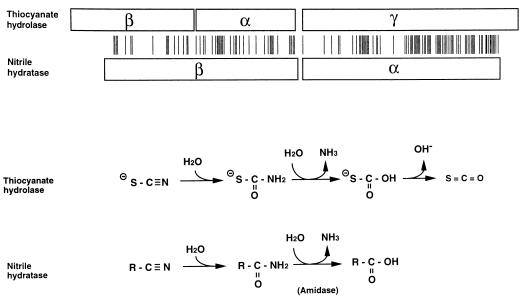FIG. 7.
Structural homology and functional similarity between thiocyanate hydrolase and nitrile hydratase. Homologous subunits (boxes) are aligned with bars indicating positions of identical amino acids. The P. chlororaphis enzyme was chosen as the representative for nitrile hydratase. The lengths of the boxes and the spaces between bars are proportional to the actual numbers of amino acid residues. The array of the thiocyanate hydrolase subunits was drawn to fit the order of scn genes, but the gene organization of nitrile hydratase subunits varies among different bacteria. In the case of P. chlororaphis, the gene coding for the β subunit is downstream of that coding for the α subunit. Thiocyanate hydrolase converts thiocyanate (SCN−) to ammonia (NH3) and COS (SCO) through several intermediates; two intermediates assumed by Katayama et al. (11) are omitted in the figure for simpler comparison. Nitrile hydratase converts nitrile (RCN) to amide (RCONH2), which is hydrolyzed by a different enzyme, amidase, to produce carboxylic acid (RCOOH) and ammonia (2).

